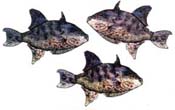 |
Striped Sea Cucumber – Thyonella gemmata Striped sea cucumbers live both in mud flats and among the roots of sea grasses. During the day their round holes are clearly seen in the hard sand, always two together, spaced from one to three inches apart. The animal borrows in a U-shape, so the anterior portion and the posterior portion are above ground, as they pump water through their bodies. Its thick skin is covered with bumpy calcareous spicules. This species has become the object of considerable scientific interest as its body contains hemoglobin, or iron rich red blood, which is highly unusual because most invertebrates have copper based blood. At night the tide flats appear to be peppered with their floriated crowns of tentacles thrusting up from the sand and mud. They sweep the water with them, picking up plankton and bits of detritus, and insert them into their mouths, like children licking off sticky fingers. During winter storms they are sometimes washed out to their burrows and cast up on the beach. Few creatures eat them, and they become an object of curiosity for the beach comber. Class: Holothuroidea |
 |
Tonguefish – Symphurus plagiusa, Small, flat, left-eyed fishes that taper to a point "tongue-shaped," hence the name. They are bottom dwelling fish, common in the muddy bottoms of bays and estuaries feeding on small crustaceans and polychaete worms. Family: Cynoglossidae/Tonguefishes |
 |
Triggerfish – Balistes capriscus, Named for the trigger-like dorsal spine that snaps erect when the fish is threatened, triggerfish have powerful jaws to crush shellfish and crustaceans. They can also remove a plug of flesh from a finger with a single bite. Family: Balistidae/Leatherjackets |
 |
Tropical Plumed Anemone – Condylactus gigantea, Large coral reef anemones from the Florida Keys that have an aray of soft pastel colors. They use their tentacles to capture and sting small planktonic animals and they also incorporate symbiotic algae into their tissues which provides them additional food. Class: Anthozoa Order: Actiniaria |
| « Previous | Next » | |
